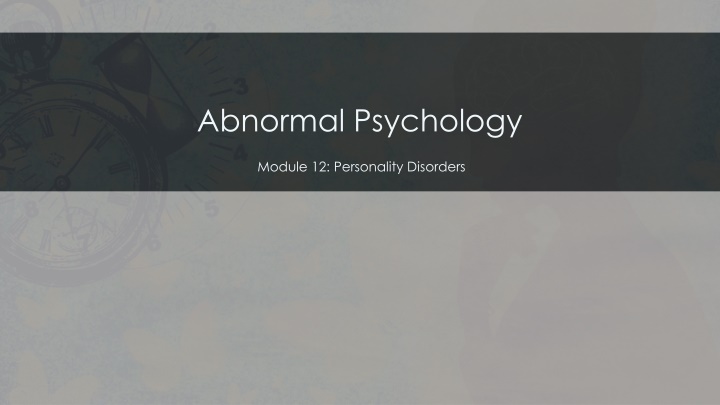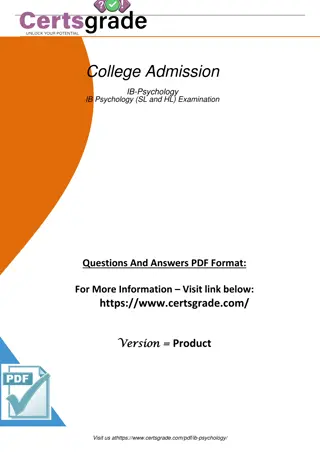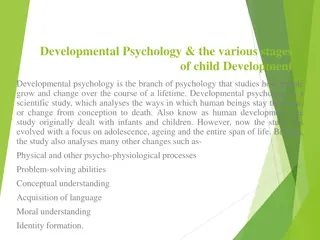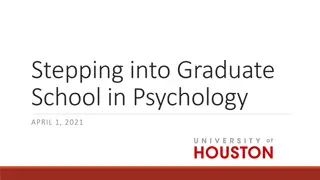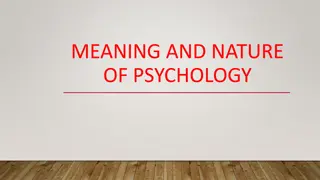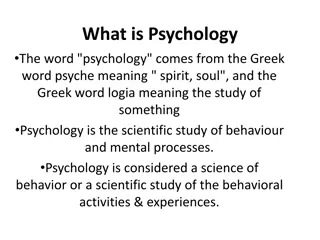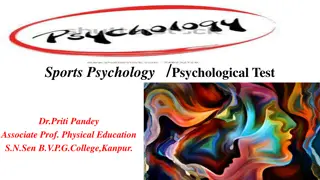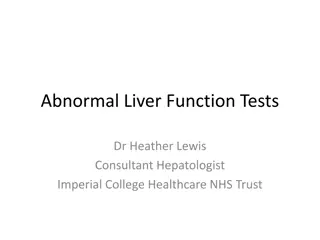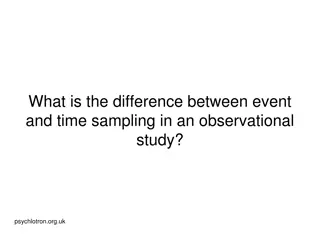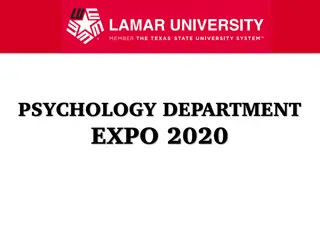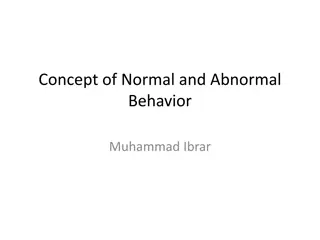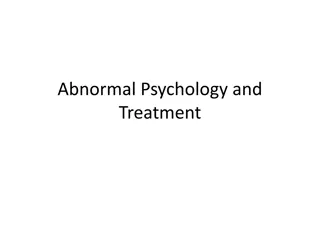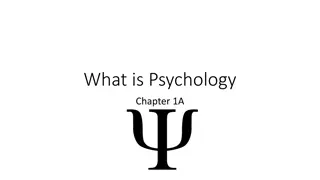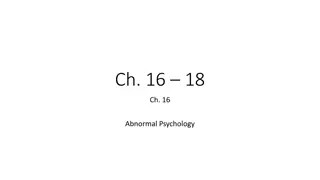Abnormal Psychology
Examine the three clusters of personality disorders - Cluster A, Cluster B, and Cluster C. Learn about the odd or eccentric types, dramatic or emotional types, and anxious or fearful types of personality disorders. Understand how these disorders differ from cultural expectations and their impact on individuals' lives.
Download Presentation

Please find below an Image/Link to download the presentation.
The content on the website is provided AS IS for your information and personal use only. It may not be sold, licensed, or shared on other websites without obtaining consent from the author.If you encounter any issues during the download, it is possible that the publisher has removed the file from their server.
You are allowed to download the files provided on this website for personal or commercial use, subject to the condition that they are used lawfully. All files are the property of their respective owners.
The content on the website is provided AS IS for your information and personal use only. It may not be sold, licensed, or shared on other websites without obtaining consent from the author.
E N D
Presentation Transcript
Abnormal Psychology Module 12: Personality Disorders
Module Learning Outcomes Examine Personality Disorders 12.1: Describe and differentiate between personality disorders 12.2: Describe and compare characteristics between cluster A personality disorders 12.3: Describe and compare characteristics of Cluster B personality disorders 12.4: Describe and compare characteristics of Cluster C personality disorders 12.5: Examine various perspectives and treatment methods related to personality disorders
Understanding Personality Disorder Clusters 12.1: Describe and differentiate between personality disorders 12.1.1: Define personality disorders and distinguish between the three clusters of personality disorders
Three Personality Disorder Clusters Personality disorders: differ markedly from the expectations of their culture, are pervasive and inflexible, and begin in adolescence or early adulthood, causing distress or impairment Cluster A: the odd or eccentric types; paranoid, schizoid, and schizotypal personality disorders. Cluster B: the dramatic, emotional, or erratic types; antisocial, borderline, histrionic, and narcissistic personality disorders. Cluster C: the anxious or fearful types; the avoidant, dependent, and obsessive- compulsive personality disorders.
Practice Question 1 Rachel is incredibly indecisive and struggles with her confidence. She has been in a relationship and/or married for the past 20 years. In fact, the longest she was single over that time period was two weeks. Considering her symptoms, in which cluster of personality disorders might Rachel s diagnosis be associated? A. Cluster A B. Cluster B C. Cluster C D. Cluster D
Understanding Cluster A Personality Disorders 12.2: Describe and compare characteristics between cluster A personality disorders 12.2.1: Describe the characteristics and diagnosis of paranoid personality disorder 12.2.2: Describe the characteristics and diagnosis of schizoid personality disorder 12.2.3: Describe the characteristics and diagnosis of schizotypal personality disorder
Paranoid Personality Disorder Paranoid personality disorder (PPD) is characterized by a general suspicion and distrust of others that presents with at least four or more of the following: suspicion that others are exploiting or harming them a preoccupation with doubting the loyalty of friends a reluctance to share information with others for fear it will be used against them views harmless comments or events as threatening or demeaning holds grudges quick to defend or attack perceived threats to their reputation or character has recurrent suspicions about the infidelity of a partner
Schizoid Personality Disorder Schizoid personality disorder (often abbreviated as SPD or SzPD) is a personality disorder characterized by a lack of interest in social relationships, a tendency toward a solitary or sheltered lifestyle, secretiveness, emotional coldness, detachment, and apathy. SPD is indicated by at least four of the following: Neither desires nor enjoys close relationships, including being part of a family. Almost always chooses solitary activities. Has little, if any, interest in having sexual experiences with another person. Takes pleasure in few, if any, activities. Lacks close friends or confidants other than first- degree relatives. Appears indifferent to the praise or criticism of others. Shows emotional coldness, detachment, or flattened affectivity.
Schizotypal Personality Disorder Schizotypal personality disorder is characterized by severe social anxiety, thought disorder, paranoid ideation, transient psychosis, and often unconventional beliefs. At least five of the following symptoms must be present: ideas of reference strange beliefs or magical thinking that influences behavior and is inconsistent with subcultural norms abnormal perceptual experiences, including bodily illusions strange thinking and speech suspiciousness or paranoid ideation inappropriate or constricted affect strange behavior or appearance lack of close friends excessive social anxiety that does not diminish with familiarity and tends to be associated with paranoid fears rather than negative judgments about self
Practice Question 2 Barry recently was worried about giving out his credit card number to a vendor for a package at a retailer. He worried that the retailer would steal his credit card number in the future. What diagnosis could be associated with Barry s behavior? A. Schizoid Personality Disorder B. Paranoid Personality Disorder C. Schizotypal Personality Disorder D. Antisocial Personality Disorder
Understanding Cluster B Personality Disorders 12.3: Describe and compare characteristics of Cluster B personality disorders 12.3.1: Describe the basic features of antisocial personality disorder and its etiology 12.3.2: Describe the characteristics and diagnosis of histrionic personality disorder 12.3.3: Describe the characteristics and diagnosis of narcissistic personality disorder 12.3.4: Describe the characteristics and diagnosis of borderline personality disorder
Antisocial Personality Disorder Antisocial Personality Disorder (ASPD) (sometimes referred to as psychopathy) involves showing no regard for other people s rights or feelings. The majority of diagnostic criteria is indicated by three (or more) of the following: Failure to conform to social norms concerning lawful behaviors, such as performing acts that are grounds for arrest. Deceitfulness, repeated lying, use of aliases, or conning others for pleasure or personal profit. Impulsivity or failure to plan. Irritability and aggressiveness, often with physical fights or assaults. Reckless disregard for the safety of self or others. Consistent irresponsibility, failure to sustain consistent work behavior, or honor monetary obligations. Lack of remorse, being indifferent to or rationalizing having hurt, mistreated, or stolen from another person.
Histrionic Personality Disorder Histrionic Personality Disorder (HPD) is characterized by a pattern of excessive attention-seeking behaviors, usually beginning in early childhood, including inappropriate seduction and an excessive need for approval. A pervasive pattern of excessive emotionality and attention-seeking, beginning by early adulthood and present in a variety of contexts, as indicated by five (or more) of the following: is uncomfortable in situations in which they are not the center of attention interaction with others is often characterized by inappropriate sexually seductive or provocative behavior displays rapidly shifting and shallow expression of emotions consistently uses physical appearance to draw attention to self has a style of speech that is excessively impressionistic and lacking in detail shows self-dramatization, theatricality, and exaggerated expression of emotion is suggestible, i.e., easily influenced by others or circumstances considers relationships to be more intimate than they actually are
Narcissistic Personality Disorder Narcissistic Personality Disorder (NPD) is characterized by the personality traits of persistent grandiosity, an excessive need for admiration, and a personal disdain and lack of empathy for other people. NPD possesses at least five of the following nine criteria: Has a grandiose sense of self-importance (e.g. exaggerates achievements and talents, expects to be recognized as superior without commensurate achievements). Is preoccupied with fantasies of unlimited success, power, brilliance, beauty, or ideal love. Believes that he/she/they is "special" and unique and can only be understood by, or should associate with, other special or high-status people (or institutions). Requires excessive admiration. Has a sense of entitlement (i.e., unreasonable expectations of especially favorable treatment or automatic compliance with their expectations). Is interpersonally exploitative (i.e., takes advantage of others to achieve their own ends). Lacks empathy: is unwilling to recognize or identify with the feelings and needs of others. Is often envious of others or believes that others are envious of him/her/them. Shows arrogant, haughty behaviors or attitudes.
Class Activity: Histrionic vs. Narcissistic PD Discuss the following with a partner: Do you think there is a connection between selfies and histrionic or narcissistic personality disorders? Why or why not? Are individuals taking selfies/pictures and posting them online or elsewhere because they think they are better looking and/or better overall than other people OR are they taking these pictures looking for attention and why?
Borderline Personality Disorder Borderline personality disorder (BPD) is a mental illness characterized by a long-term pattern of unstable relationships, distorted sense of self, and strong emotional reactions. Diagnosis consists of 5 or more of the following: Frantic efforts to avoid real or imagined abandonment. Doesn t include suicidal or self-mutilating behavior covered in criterion 5. A pattern of unstable and intense interpersonal relationships characterized by alternating between extremes of idealization and devaluation Identity disturbance: Markedly and persistently unstable self-image or sense of self Impulsivity in at least 2 areas that are potentially self-damaging, for example, spending, sex, substance abuse, reckless driving, binge eating. Note: Do not include suicidal or self-mutilating behavior covered in criterion 5. Affective instability due to a marked reactivity of mood, for example, intense episodic dysphoria, irritability, or anxiety usually lasting a few hours and only rarely more than a few days Chronic feelings of emptiness Inappropriate, intense anger or difficulty controlling anger, for example, frequent displays of temper, constant anger, recurrent physical fights Transient, stress-related paranoid ideation or severe dissociative symptoms
Practice Question 3 Michele had recently felt horrible about herself and her behavior. Michele made an impulsive choice the night before by hooking up with a stranger who she had just met. Michele realized this was not the first time and felt depressed and anxious about this. Based on Michele s recent behavior, what could be a diagnosis that would be consistent with her case? A. Antisocial Personality Disorder B. Histrionic Personality Disorder C. Narcissistic Personality Disorder D. Borderline Personality Disorder
Understanding Cluster C Personality Disorders 12.4: Describe and compare characteristics of Cluster C personality disorders 12.4.1: Describe the characteristics and diagnosis of avoidant personality disorder 12.4.2: Describe the characteristics and diagnosis of dependent personality disorder 12.4.3: Describe the characteristics and diagnosis of obsessive-compulsive personality disorder
Avoidant Personality Disorder Individuals with Avoidant Personality Disorder (AvPD): consider themselves to be socially inept or personally unappealing and avoid social interaction for fear of being ridiculed, humiliated, rejected, or disliked. Four of seven symptoms should be present: avoids occupational activities that involve significant interpersonal contact, because of fears of criticism, disapproval, or rejection is unwilling to get involved with people unless certain of being liked shows restraint within intimate relationships because of the fear of being shamed or ridiculed is preoccupied with being criticized or rejected in social situations is inhibited in new interpersonal situations because of feelings of inadequacy views self as socially inept, personally unappealing, or inferior to others is unusually reluctant to take personal risk or to engage in any new activities because they may prove embarrassing
Dependent Personality Disorder Dependent personality disorder (DPD): a long-term condition in which people depend on others to meet their emotional and physical needs, with only a minority achieving normal levels of independence.At least five of the following factors: Has difficulty making everyday decisions without an excessive amount of advice and reassurance from others. Needs others to assume responsibility for most major areas of their life. Has difficulty expressing disagreement with others because of fear of loss of support or approval. Has difficulty initiating projects or doing things on their own (because of a lack of self-confidence in judgment or abilities rather than a lack of motivation or energy). Goes to excessive lengths to obtain nurturance and support from others, to the point of volunteering to do things that are unpleasant. Feels uncomfortable or helpless when alone because of exaggerated fears of being unable to care for themselves. Urgently seeks another relationship as a source of care and support when a close relationship ends. Is unrealistically preoccupied with fears of being left to take care of themselves.
Obsessive-Compulsive Personality Disorder Obsessive compulsive personality disorder (OCPD) is a cluster C personality disorder marked by an excessive need for orderliness, neatness, and perfectionism. Marked by an excessive obsession with: rules, lists, schedules, and order; a need for perfectionism that interferes with efficiency and the ability to complete tasks a devotion to productivity that hinders interpersonal relationships and leisure time rigidity and zealousness on matters of morality and ethics an inability to delegate responsibilities or work to others.
Practice Question 4 Jasmine has been in a relationship with her boyfriend for about 2 years and he recently said that something needed to change as she relies too much on her parents even though she is in her late 20 s. Jasmine asks her parents about every decision in her life and talks to them at least once if not more each day, confiding in them about everything. Jasmine s boyfriend has had issues with the dynamic, but finally had enough when her parents confided with Jasmine almost as their therapist and then showed up unannounced when they had plans. What is the likely diagnosis for Jasmine? A. Avoidant Personality Disorder B. Dependent Personality Disorder C. Obsessive-Compulsive Personality Disorder D. Antisocial Personality Disorder
Perspectives and Treatments 12.5: Examine various perspectives and treatment methods related to personality disorders 12.5.1: Describe viewpoints from the major psychological perspectives related to the etiology of personality disorders 12.5.2: Describe treatment options and complications in treating personality disorders
Perspectives on Personality Disorders Biological: genetic research for the understanding of the development of personality disorders is severely lacking. Psychodynamic: proposes events that happen to us in our childhood impacts our lives as we mature. Cognitive: proposes a link between personality and disruptive and disordered thought patterns. Behavioral: people behave in a consistent manner and view personality as being shaped by reinforcements and consequences. Sociocultural: child abuse and neglect consistently show up as risk factors to the development of personality disorders in adulthood. Socioeconomic status has also been looked at as a potential cause for personality disorders.
Treatment Options for Personality Disorders Some modalities of treatment used for personality disorders include: Individual psychotherapy Family therapy, including couples therapy Group therapy for personality dysfunction Psychological-education and self-help groups Psychiatric medications for treating symptoms of personality dysfunction or co-occurring conditions. Milieu therapy, a kind of group-based residential approach, has a history of use in treating personality disorders, including therapeutic communities The practice of mindfulness that includes developing the ability to be nonjudgmentally aware of unpleasant emotions appears to be a promising clinical tool for managing different types of personality disorders. Dialectical behavior therapy, a form of cognitive-behavior therapy that draws on principles from Zen Buddhism, dialectical philosophy, and behavioral science.
Practice Question 5 Recently, Dave seems to be obsessed with making lists for a great deal of things within his life, and these lists are becoming more and more obsessive. Dave s father also has shown signs of Obsessive-Compulsive Personality Disorder. Considering his father s symptoms, which would be a perspective that explains Dave s diagnosis of OCPD? A. Biological B. Cognitive C. Behavioral D. Psychodynamic
Case Studies: Borderline Personality Disorder Emily: Emily was diagnosed with BPD after she had recent depression based on the impulsive behaviors that she was showing that were negative. Emily sought treatment, but before she completed the therapy, she left and acted out impulsively again and became depressed again. Emily finally realized that she needed to stick with treatment and she was finally happy. Emily met someone that she enjoyed spending time with and felt like herself for the first time in a while. Grace: Grace was undiagnosed with BPD, but showed tendencies. Grace would meet a guy one night and would text and call him over 200 times the next day. Grace remained untreated for years until she hit rock bottom and needed treatment. Grace was successful in her treatment; addressing her self- esteem and impulsive actions were core to helping her get better.
Case Study: Histrionic Personality Disorder Amber: Amber has looked for a perfect match for herself for years. Amber aims to seek attention from the guys that she dates as she will text them a lot and wants to feel wanted. Amber has recently realized that by her always seeking attention, she has not truly understood herself and sought treatment. Amber went to a therapist and her self-esteem increased and her constant need for attention lessened. Amber started feeling much better about herself and the decisions she was making for the future.
